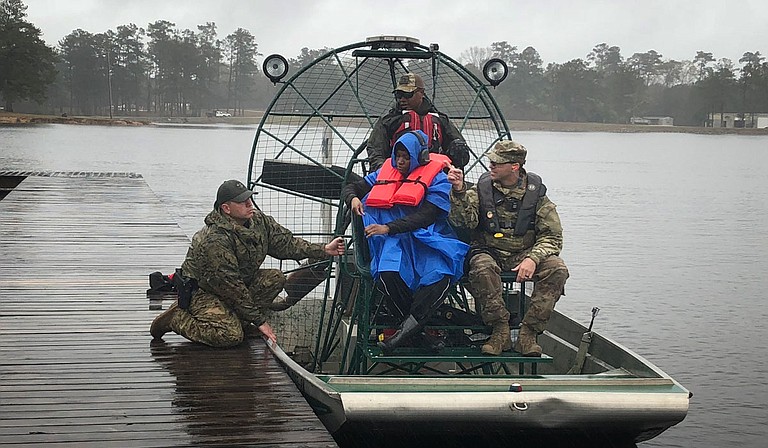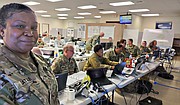U.S. Army National Guard units joined with state agency personnel this week at Camp Shelby near Hattiesburg, including some of Jackson's own first responders, drilling the coordination and cohesion necessary in a massive natural disaster. Photo by Julian Mills
Friday, March 6, 2020
Fanboats and speedboats lanced through Geiger Lake in Forrest County this Wednesday, carrying National Guardsmen and specialists from the Mississippi Department of Wildlife, Fisheries and Parks' Special Response Team.
Across the lake, "survivors" languished, pelted by freezing rain and desperate for rescue. As the soldiers neared the docks, the stranded group clustered together, many begging to be taken first: some injured, some elderly. The first responders triaged the situation, selecting an infirm woman in a wheelchair as the first rescue.
Miles away, in the Joint Operations Center, or JOC, at Camp Shelby, Mississippi Army National Guard Maj. Fanneta Battle studied the scenario. In front of her, projectors splashed data feeds across the walls of the command center. A soldier announced a potential chemical spill along a roadway near the coast, and Battle deployed a team to address the threat. Pending missions hovered next to a live feed of drone and helicopter footage overseeing the area. Beside that was a live map of deployed units and outstanding issues.
Back on the lake, one of the rescuers slipped on the rain-slick surface of the boat launch, just managing to catch himself on the edge of the boat and clambering back to his feet, a sheepish smile on his face. The "elderly survivor" could not help but to laugh: she was a soldier too. They departed without further issue, another successful rescue. For Battle, it was one more task checked off an endless list displayed on the Domestic Operations Awareness and Assessment Response Tool or DAART. All of those missions add up to a full day of "PATRIOT South," a joint training exercise held over the last week at Camp Shelby, near Hattiesburg.
Battle took a long road to where she is now. She returned from her deployment in Kuwait in 2005, just before Hurricane Katrina ravaged the Gulf Coast, claiming more than 1,800 lives and nearly eradicating entire communities across Louisiana and Mississippi. Battle remembers the chaos and confusion of the disaster well: she lived through it. "(My husband and I) evacuated to my mother's house in Hattiesburg. We were trapped in our own neighborhood—trees were stacked outside like dominoes," Battle said in a Wednesday interview in the JOC, cool glow of the DAART screens illuminating her in profile.
At the time, Battle was a second lieutenant, and quickly reported to the Combined Readiness Training Center in Gulfport once free from her own travails. Her role remained fluid in the days to come. "A lot of people couldn't get back to the unit, so I had to serve as a jack of all trades, because of the lag time with everyone else," she explained.
Battle now serves in a far more senior position that she did in 2005: she orchestrates mission control for the JOC, the nervous system of the coordinated disaster response command. "Katrina gave everyone that 'eyes wide open' moment. We're far more advanced, far more ready," she said.
The aftermath of Katrina became an inflection point for disaster response in the United States. Outdated communications technology and poor cross-agency coordination wasted valuable time in the days after the storm receded. Now, 15 years on, Mississippi and many other states have a new integrated system for disaster response operations.
Maj. Dale Bell commands the Mississippi Department of Wildlife, Fisheries and Parks' Special Response Team, or SRT. Last month, as the Pearl River inundated neighborhoods in Jackson, Bell and his team helped evacuate residents trapped by rising floodwaters, patrolled submerged neighborhoods and safely guided residents through dangerous areas. At PATRIOT South, the SRT coordinated simulation exercises of some of the same water rescues that they actually performed in weeks past.
Hurricane Katrina is fresh in Bell's memory as well. "People weren't prepared for Katrina," Bell told the Jackson Free Press in a muddy field near Camp Shelby. "And the ones that thought they were prepared were underestimating it." Nearby, in a mobile command center, soldiers from all across the nation directed exercises from the field.
Disaster relief can require a different philosophy than any other kind of operation. "Hurt people (can) hurt people," Bell said. Law enforcement personnel have to be ready to engage with injured, terrified, emotionally compromised survivors, he explained.
Training soldiers and first responders in simulated rescue operations is important. But the crucial, underlying purpose of the exercises is to improve communication and coordination. "Katrina was a catalyst for several things," Michael Bolden, deputy administrator for the Mississippi Department of Wildlife, Fisheries and Parks explained. First and foremost was a reassessment of the redundant or poorly defined responsibilities shared by the agencies involved in a disaster of that scale. Disorganization over the division of labor creates dangerous logjams in critical moments. This, too, is key to the value of an exercise like PATRIOT South.
The second was investment in the state's newly created wireless commission. "One of the first things that happened is all the power goes, (preventing) the ability for one police department to talk to the one in the next county, or the fire department," Bolden said.
The creation of an integrated communications network durable enough for an event as destructive as Katrina was no longer optional. While soldiers and law enforcement personnel completed training exercises in the area surrounding Camp Shelby, others gathered in the center of the complex, where the hardware for that network resides.
The National Guard designed DAART to serve first responders and civilians alike. The system operates without using classified information, meaning anyone is allowed to create an account and monitor the same data stream used to coordinate disaster response—although that access requires an online training course, and is subject to monitoring and revocation.
Administrators and responders alike display a quiet pride in the Guard's readiness for another massive disaster. "It's very comforting to see how far we've come," Battle says. In Jackson, swift communication of the evacuation order and the SRT's response to the Pearl River floods helped prevent injury or loss of life. Bell sees the training exercises his team organized and executed as a model for the same response to a much larger event. "There's a gamut of things that can change a flood plan," Bell said. But he intends to be ready.
Email state reporter Nick Judin at [email protected] and follow him on Twitter at @nickjudin. State intern Julian Mills contributed to this report.


Comments
Use the comment form below to begin a discussion about this content.
Sign in to comment
Or login with:
OpenID